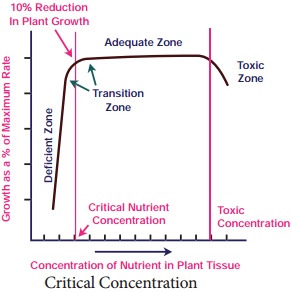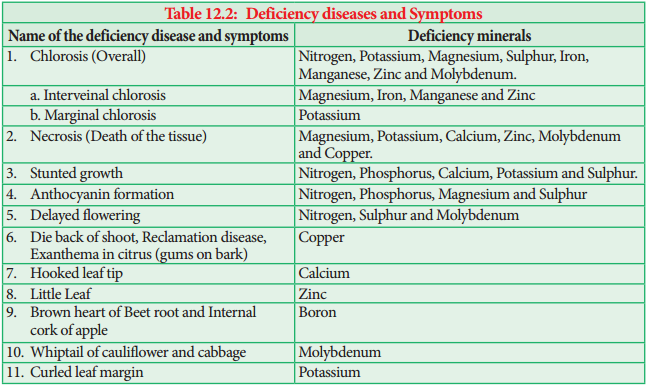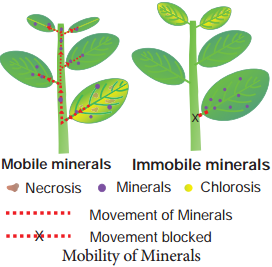Learninsta presents the core concepts of Biology with high-quality research papers and topical review articles.
Critical Concentration and Toxicity of Minerals
Critical Concentration
To increase the productivity and also to avoid mineral toxicity knowledge of critical concentration is essential. Mineral nutrients lesser than critical concentration cause deficiency symptoms. Increase of mineral nutrients more than the normal concentration causes toxicity. A concentration, at which 10% of the dry weight of tissue is reduced, is considered as toxic. Figure 12.2 explains about Critical Concentration.

Mineral Toxicity
a. Manganese Toxicity
Increased Concentration of Manganese will prevent the uptake of Fe and Mg, prevent translocation of Ca to the shoot apex and cause their deficiency. The symptoms of manganese toxicity are appearance of brown spots surrounded by chlorotic veins.
b. Aluminium Toxicity
Aluminium toxicity causes precipitation of nucleic acid, inhibition of ATPase, inhibition of cell division and binding of plasma membrane with Calmodulin. For theories regarding, translocation of minerals please refer Chapter – 11.
Critical concentration. (Science: chemistry) The minimum concentration of units needed before a biological polymer will form. Examples of biopolymers are microtubules from tubulin units, polypeptides from amino acid units, polysaccharides from simple Sugar units, etc.
The term mineral toxicity refers to a condition during which the concentration within the body of anybody of the minerals necessary for all times is abnormally high, and which has an adverse effect on health.
Critical level or concentration is a term that is common in both soil and plant analysis. It is usually defined in plant analysis as the level that results in 90% of maximum yield or growth, which is also a reasonable division of the zones of adequacy and deficiency in the figure below.
These include iron, manganese, copper, molybdenum, zinc, boron, chlorine and nickel. Toxic Elements Any mineral ion concentration in tissues, that reduces the dry weight of tissues by about 10% is considered toxic. For example, Mn inhibit the absorption of other elements.
As a group, minerals are one of the four groups of essential nutrients, the others of which are vitamins, essential fatty acids, and essential amino acids. The five major minerals in the human body are calcium, phosphorus, potassium, sodium, and magnesium.
Critical nutrient range is defined as: that range of nutrient concentration above which we are reasonably confident the crop is amply supplied and below which we are reasonably confident the crop is deficient.
Soil pH affects nutrient availability by changing the form of the nutrient in the soil. Adjusting soil pH to a recommended value can increase the availability of important nutrients. Low pH reduces the availability of the macro- and secondary nutrients, while high pH reduces the availability of most micronutrients.
These symptoms include cardiac arrhythmias, headache, nausea and vomiting, and in severe cases, seizures. Calcium and phosphate: Calcium and phosphate are closely related nutrients.
Critical Concentration is the term which is used to define the concentration of essential elements below which the growth of plant is Retarded or Reduced. Also, if the concentration of essential elements rise above the critical concentrations it leads to toxicity.
Calcium is required by meristematic and differentiating tissues. During cell division it is used in the synthesis of cell wall, particularly as calcium pectate in the middle lamella. It is also needed during the formation of mitotic spindle. It accumulates in older leaves. The criteria of essentiality were stated by Arnon and Stout.
The three criteria of essentiality of an element are:
- Deficiency of the given element must cause some specific deficiency symptom so that the vegetative and reproductive stages of the life cycle of plant remain imcomplete.
- Such 8 deficiency symptom can be prevented or corrected only by supplying this element.
The element must be critical for the growth and development of the plant. The plant can not complete its life cycle or produce seeds in the absence of the element. The requirement for the element must be specific and not replaceable by another element.
The beneficial elements are not deemed essential for all crops but may be vital for particular plant taxa. The distinction between beneficial and essential is often difficult in the case of some trace elements. These elements are not critical for all plants but may improve plant growth and yield.


